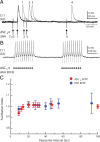Coordination of rhythmic motor activity by gradients of synaptic strength in a neural circuit that couples modular neural oscillators
- PMID: 19625525
- PMCID: PMC2732425
- DOI: 10.1523/JNEUROSCI.1744-09.2009
Coordination of rhythmic motor activity by gradients of synaptic strength in a neural circuit that couples modular neural oscillators
Abstract
Synchronization of distributed neural circuits is required for many behavioral tasks, but the mechanisms that coordinate these circuits are largely unknown. The modular local circuits that control crayfish swimmerets are distributed in four segments of the CNS, but when the swimmeret system is active their outputs are synchronized with a stable intersegmental phase difference of 0.25, an example of metachronal synchronization (Izhikevich, 2007). In each module, coordinating neurons encode detailed information about each cycle of the module's motor output as bursts of spikes, and their axons conduct this information to targets in other segments. This information is both necessary and sufficient for normal intersegmental coordination. In a comprehensive set of recordings, we mapped the synaptic connections of two types of coordinating neurons onto their common target neurons in other segments. Both types of coordinating axons caused large, brief EPSPs in their targets. The shape indices of these EPSPs are tuned to transmit the information from each axon precisely. In each target neuron's own module, these bursts of EPSPs modified the phase of the module's motor output. Each axon made its strongest synapse onto the target neuron in the nearest neighboring segment. Its synapses onto homologous targets in more remote segments were progressively weaker. Each target neuron decodes information from several coordinating axons, and the strengths of their synapses differ systematically. These differences in synaptic strength weight information from each segment differently, which might account for features of the system's characteristic metachronal synchronization.
Figures









Similar articles
-
Proprioceptive feedback modulates coordinating information in a system of segmentally distributed microcircuits.J Neurophysiol. 2014 Dec 1;112(11):2799-809. doi: 10.1152/jn.00321.2014. Epub 2014 Sep 3. J Neurophysiol. 2014. PMID: 25185816 Free PMC article.
-
Bursts of information: coordinating interneurons encode multiple parameters of a periodic motor pattern.J Neurophysiol. 2006 Feb;95(2):850-61. doi: 10.1152/jn.00939.2005. Epub 2005 Oct 19. J Neurophysiol. 2006. PMID: 16236775
-
Not by spikes alone: responses of coordinating neurons and the swimmeret system to local differences in excitation.J Neurophysiol. 2007 Jan;97(1):436-50. doi: 10.1152/jn.00580.2006. Epub 2006 Oct 18. J Neurophysiol. 2007. PMID: 17050832
-
Neurobiology of the crustacean swimmeret system.Prog Neurobiol. 2012 Feb;96(2):242-67. doi: 10.1016/j.pneurobio.2012.01.002. Epub 2012 Jan 14. Prog Neurobiol. 2012. PMID: 22270044 Free PMC article. Review.
-
Intersegmental coordination of swimmeret movements: mathematical models and neural circuits.Ann N Y Acad Sci. 1998 Nov 16;860:266-80. doi: 10.1111/j.1749-6632.1998.tb09055.x. Ann N Y Acad Sci. 1998. PMID: 9928318 Review.
Cited by
-
A Single Central Pattern Generator for the Control of a Locomotor Rolling Wave in Mollusc Aplysia.Research (Wash D C). 2023;6:0060. doi: 10.34133/research.0060. Epub 2023 Mar 6. Research (Wash D C). 2023. PMID: 36930762 Free PMC article.
-
Mechanisms of coordination in distributed neural circuits: decoding and integration of coordinating information.J Neurosci. 2014 Jan 15;34(3):793-803. doi: 10.1523/JNEUROSCI.2642-13.2014. J Neurosci. 2014. PMID: 24431438 Free PMC article.
-
Functional motifs composed of morphologically homologous neurons repeated in the hindbrain segments.J Neurosci. 2014 Feb 26;34(9):3291-302. doi: 10.1523/JNEUROSCI.4610-13.2014. J Neurosci. 2014. PMID: 24573288 Free PMC article.
-
Keeping it together: mechanisms of intersegmental coordination for a flexible locomotor behavior.J Neurosci. 2010 Feb 10;30(6):2373-83. doi: 10.1523/JNEUROSCI.5765-09.2010. J Neurosci. 2010. PMID: 20147563 Free PMC article.
-
Proprioceptive feedback modulates coordinating information in a system of segmentally distributed microcircuits.J Neurophysiol. 2014 Dec 1;112(11):2799-809. doi: 10.1152/jn.00321.2014. Epub 2014 Sep 3. J Neurophysiol. 2014. PMID: 25185816 Free PMC article.
References
-
- Canavier CC. Phase response curve. Scholarpedia. 2006;1:1332.
-
- Cang J, Friesen WO. Model for intersegmental coordination of leech swimming: central and sensory mechanisms. J Neurophysiol. 2002;87:2760–2769. - PubMed
-
- Davis WJ. The neuromuscular basis of lobster swimmeret beating. J Exp Zool. 1968;168:363–378.
-
- Friesen WO, Cang JH. Sensory and central mechanisms control intersegmental coordination. Curr Opin Neurobiol. 2001;11:678–683. - PubMed
-
- Grillner S. Control of locomotion in bipeds, tetrapods and fish. In: Brooks VB, editor. Handbook of physiology, the nervous system. Vol 2. Baltimore: Williams and Wilkens; 1981. pp. 1179–1236. Motor control.
Publication types
MeSH terms
Grants and funding
LinkOut - more resources
Full Text Sources
Other Literature Sources
